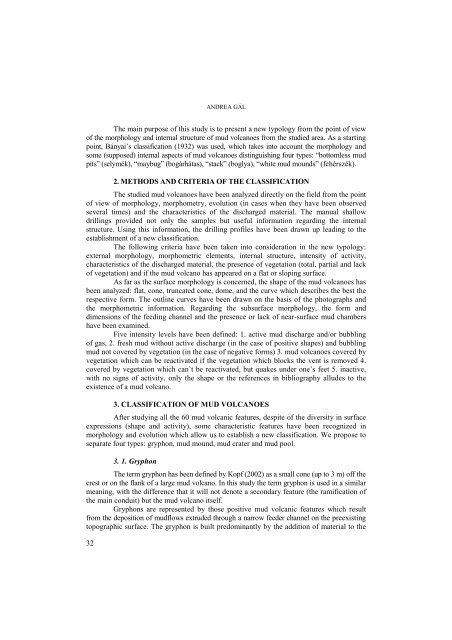geographia - Studia
geographia - Studia
geographia - Studia
Create successful ePaper yourself
Turn your PDF publications into a flip-book with our unique Google optimized e-Paper software.
ANDREA GÁL<br />
The main purpose of this study is to present a new typology from the point of view<br />
of the morphology and internal structure of mud volcanoes from the studied area. As a starting<br />
point, Bányai’s classification (1932) was used, which takes into account the morphology and<br />
some (supposed) internal aspects of mud volcanoes distinguishing four types: “bottomless mud<br />
pits” (selymék), “maybug” (bogárhátas), “stack” (boglya), “white mud mounds” (fehérszék).<br />
32<br />
2. METHODS AND CRITERIA OF THE CLASSIFICATION<br />
The studied mud volcanoes have been analyzed directly on the field from the point<br />
of view of morphology, morphometry, evolution (in cases when they have been observed<br />
several times) and the characteristics of the discharged material. The manual shallow<br />
drillings provided not only the samples but useful information regarding the internal<br />
structure. Using this information, the drilling profiles have been drawn up leading to the<br />
establishment of a new classification.<br />
The following criteria have been taken into consideration in the new typology:<br />
external morphology, morphometric elements, internal structure, intensity of activity,<br />
characteristics of the discharged material, the presence of vegetation (total, partial and lack<br />
of vegetation) and if the mud volcano has appeared on a flat or sloping surface.<br />
As far as the surface morphology is concerned, the shape of the mud volcanoes has<br />
been analyzed: flat, cone, truncated cone, dome, and the curve which describes the best the<br />
respective form. The outline curves have been drawn on the basis of the photographs and<br />
the morphometric information. Regarding the subsurface morphology, the form and<br />
dimensions of the feeding channel and the presence or lack of near-surface mud chambers<br />
have been examined.<br />
Five intensity levels have been defined: 1. active mud discharge and/or bubbling<br />
of gas, 2. fresh mud without active discharge (in the case of positive shapes) and bubbling<br />
mud not covered by vegetation (in the case of negative forms) 3. mud volcanoes covered by<br />
vegetation which can be reactivated if the vegetation which blocks the vent is removed 4.<br />
covered by vegetation which can’t be reactivated, but quakes under one’s feet 5. inactive,<br />
with no signs of activity, only the shape or the references in bibliography alludes to the<br />
existence of a mud volcano.<br />
3. CLASSIFICATION OF MUD VOLCANOES<br />
After studying all the 60 mud volcanic features, despite of the diversity in surface<br />
expressions (shape and activity), some characteristic features have been recognized in<br />
morphology and evolution which allow us to establish a new classification. We propose to<br />
separate four types: gryphon, mud mound, mud crater and mud pool.<br />
3. 1. Gryphon<br />
The term gryphon has been defined by Kopf (2002) as a small cone (up to 3 m) off the<br />
crest or on the flank of a large mud volcano. In this study the term gryphon is used in a similar<br />
meaning, with the difference that it will not denote a secondary feature (the ramification of<br />
the main conduit) but the mud volcano itself.<br />
Gryphons are represented by those positive mud volcanic features which result<br />
from the deposition of mudflows extruded through a narrow feeder channel on the preexisting<br />
topographic surface. The gryphon is built predominantly by the addition of material to the

















